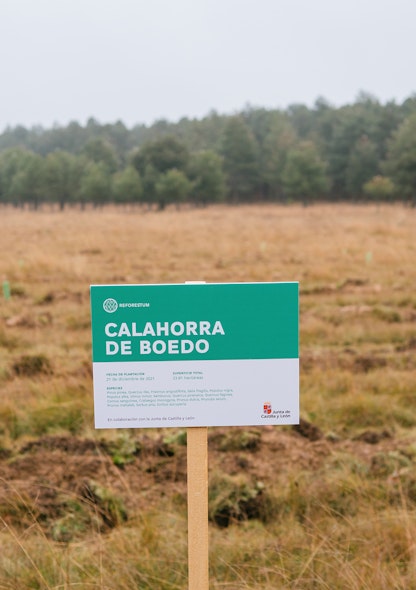What makes a good carbon offset
5 Requirements for high-quality carbon offsets
Once you are aware of the concept of carbon offset and future removals, there are four primary criteria which define where carbon offsets or future removal is worth funding: additionality, verified accounting, no leakage, permanence and holistic approach.
1. Additionality
Does the offset result in there being less carbon in the atmosphere than if it had not been purchased in the first place?
Any worthwhile offset or future removal must guarantee that there is an additional effect in terms of carbon storage that would not occur without the compensating project with which it is associated.
This means that a good offset must guarantee that there is more carbon stored than if it had not been implemented. To put it another way, an offset would not be worthwhile if the project where it comes from can be funded by outputs other than carbon compensation.
By selling carbon offsets or future removals in the form of supporting renewable energy infrastructure that would have been funded regardless, for example, the total amount of carbon in the atmosphere is not actually reduced.
This may result in a common problem for poor quality carbon offsets or future removals, whereby the amount of carbon in the atmosphere actually increases, due to the continued carbon-producing activities of the organisation or individual who has purchased the offset. That is, without ensuring the additionality of an offset, they may in fact achieve the opposite of what they are intended for.
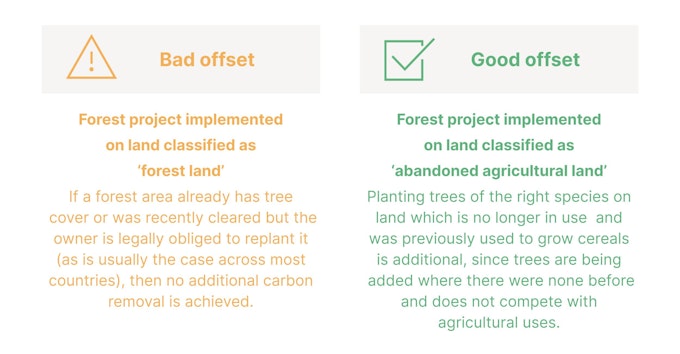
2. Verified accounting
Has the carbon reduction related to the offset been properly accounted for?
A project developer must be able to demonstrate plainly through reliable, proven methodologies how they have calculated and thereafter sold the carbon offsetting capacity of a given project, in order to give as accurate an indicator as possible of the actual carbon removed or avoided.
Basically, good offset or future removal must be measurable and reliably verifiable, which is ensured by recognised and credibly governed standards. The methodologies used vary depending on the type of project and on countries, among others.
As explained in the first article, generally, it’s important to differentiate between ex-post and ex-ante calculations, which indicate, respectively, the amount of carbon already offset and the estimated future CO2 absorption or avoidance.
If we look at the types of forestry projects featured in Reforestum’s portfolio more specifically, these are the accounting principles used:
- Afforestation projects - The carbon offset is calculated by estimating the carbon stored by the new forest since the last time it was measured based on the number of live trees and their size.
- Conservation and restoration forestry projects - The carbon offset by these projects is calculated by comparing the actual state of the protected forest with the ‘non-intervention baseline scenario’. The term baseline scenario refers to the estimated condition of the ecosystem at a given point in time if the project had not taken place. With the right conservation efforts, the intervention should be positive and deforestation highly reduced or even eliminated. However, it is difficult to demonstrate the counterfactual scenario and accurately measure the emissions that would have occurred without the project, which means the amount of associated offsets generated may be over-exaggerated.
Rigorous accounting also helps to avoid the persistent issue of 'double-counting', which ‘occurs when the same reduction is counted towards achievement of two separate goals.’ This happens, for example, when an offset is counted against the carbon emissions both of the country where it was implemented as well as against the emissions of the country or organisation that purchased it.
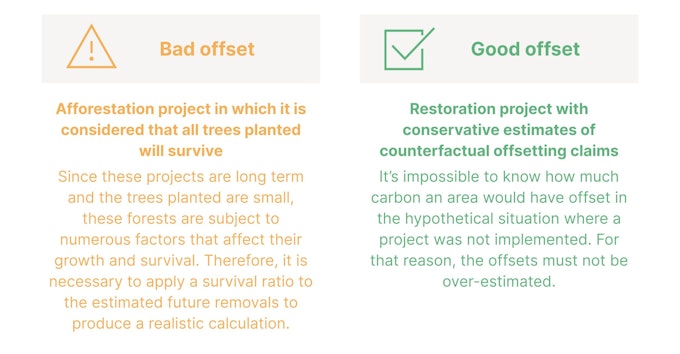
3. No leakage
Does the offset simply shift the carbon emissions, deforestation or conventional energy use to other locations?
Leakage refers to the negative carbon impact that happens when avoiding environmental damage or emissions in one area are simply displaced to another area.
This is a risk for any environmental project and especially for those related to conservation efforts in areas subject to significant pressures due to illegal logging for timber or other uses. This risk is systematically assessed as part of third-party certifications and accreditation bodies and varies widely depending on project types.
Where risks of leakage are identified, significant efforts must go into the planning and execution of projects, including community involvement, in order to address those risks in a systemic way and prevent leakage to undermine positive impacts in one area through negative impacts in another. It is all the more important as leakage might not be easily visible, and therefore negative impacts elsewhere could go unnoticed if not planned and monitored adequately.
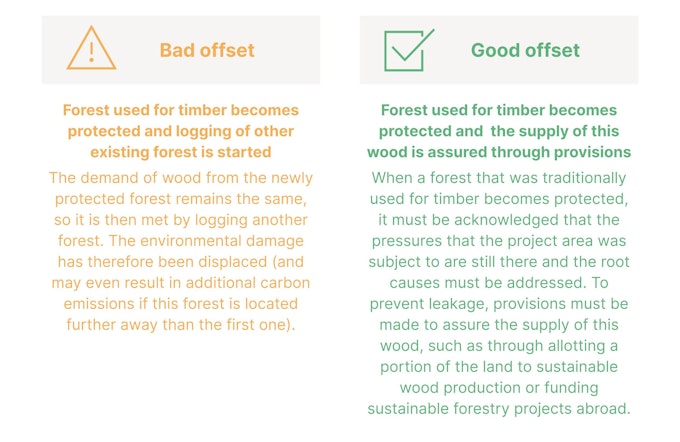
4. Permanence
Have steps been taken to ensure carbon will remain securely stored?
Ultimately, a worthwhile carbon offset must remain securely stored for the long term. Although ‘short-lived’ solutions - as outlined in the Oxford Principles for Net Zero Aligned Carbon Offsetting - are useful to ‘help buy time to reduce emissions and invest in long-lived storage […] they are not a long-term solution for achieving the balance between sinks and sources.’
While it is impossible to achieve 100% certainty that carbon remains in the ground, an organisation can greatly mitigate the likelihood of carbon being re-released into the atmosphere by assessing a site’s ‘permanence’ (how long it is likely to be able to store carbon). This goes beyond mere analysis of the innate resilience of the offset itself (such as the total carbon a peat bog can hold) and must factor in a holistic assessment of risk. This might include assessing the geopolitics of the region as well as considering local legislation.
According to the Oxford Principles for Carbon Offsetting, human-made solutions such as using geological reservoirs or re-mineralising carbon tend to be much more inert and secure than biological carbon sinks, and thus constitute an essential part of a Net-Zero strategy.
However, because further research into the potential for the stored emissions to leak out is still required, and due to their comparatively low level of additionality in other areas such as ecosystem regeneration, ‘nature-based’ solutions remain a vital part of this strategy too. In the case of such ‘nature-based solutions’, maintenance of the offset project is especially important, as their permanence is typically less secure than with human-made solutions.
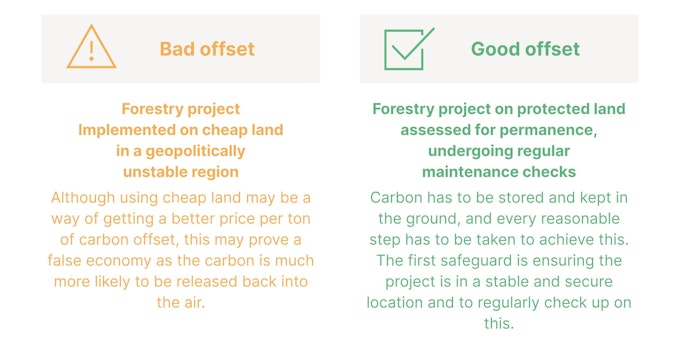
5. Holistic approach
Does the offset have disproportionately harmful knock-on effects on people and the environment more generally?
A good offset also has to take into account the whole human and ecological system it impacts and aims to achieve a balance which is healthy overall. That means considering all aspects of the environment, from other GHG emissions to biodiversity, as well as human life and wellbeing, from indigenous rights to supporting livelihoods.
After all, carbon reduction is not an end in itself, but a means to improve conditions on our planet for all life. That is why offsets and future carbon removals should come from activities that are compatible with human rights, promote equity, apply social safeguards, demonstrate positive socio-economic impact and contribute to the protection and enhancement of environmental quality.

The Reforestum approach
Reforestum is able to ensure all of these criteria are met through a rigorous and careful selection and design process when choosing which projects to promote and support.
When it comes to carbon offsets, knowing how to choose a reliable forest project, as well as understanding regulatory bodies and certifications, is crucial. The good news is that Reforestum does this for its clients through diligent curation of all of the projects we support and can find the ones that best meet the needs of your business.
Our expertise and network in the market make us connected to the best forest developers and providers worldwide with whom we share our values. Developing close relationships with projects and communities, therefore, who have intimate knowledge of the land and are able to give feedback according to their lived experience of the impact the project has, is absolutely essential. There are no shortcuts in this process. As with trust in any relationship, it is something that becomes visible over time due to the long-term health and sustainability of the projects, and through the demonstration of a commitment to such sustainability from all parties.
This commitment to maintaining on the ground these relationships and attaining the highest level certifications for our projects also means we can reliably defend the offsetting claims we make.



